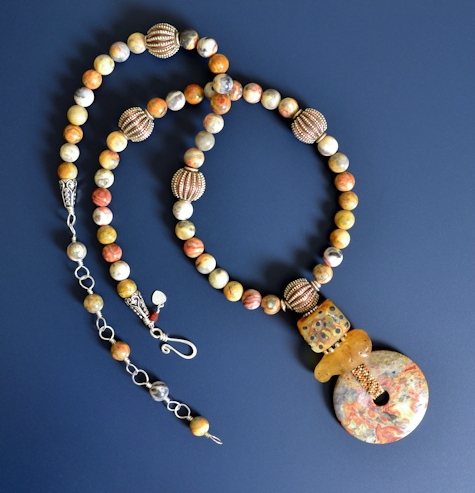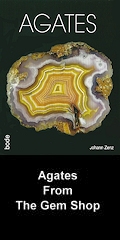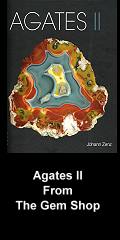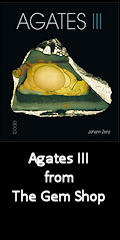Some readers will recognize I'm dating myself by calling this donut pendant a "pi." That is the old-fashioned Wade-Giles transliteration of the Chinese character 璧, which according to my favorite on-line Chinese dictionary means "piece of jade with a hole in it," or more poetically from Karlgren, "circular jade insignium." Today the character is transliterated "bi" according to the Pinyin system which is closer to an English spelling of the Chinese sound. In Mandarin it sounds like "bee" with emphasis on the "b." Now any kind of stone with this shape is called a pi or bi, the term no longer seems restricted to jade.
As you may know, traditional Chinese ideograms or characters are little stories in themselves, and this character is no exception. It contains two parts, the lower half meaning "jade" or "precious stone" and the upper meaning "open up, develop; also rule, law." These parts can be broken down further. The character for "open up, develop" itself has two parts. The left contains two elements, "corpse" which includes the sense of sitting motionless, and "mouth" which could refer to the opening in a pi. The upper right is is radical 160, which Matthews translates as "bitter, acrid; from which comes the idea of distressing, toilsome, grievous." So this one character is a veritable video of the toilsome effort of sitting (virtually) motionless carving a mouth in a piece of jade! You get the sense of how long it used to take (jade is hard and very tough because of its intergrown crystal structure, cutting and polishing it without today's power tools must have taken forever). When you start exploring traditional Chinese, you begin to understand how incredibly rich these images are, and therefore how impossible it is to produce a single definitive translation of any Chinese master work, as impossible as trying to "translate" a beautiful painting into English.
Oh my, how did I get off on that? You probably thought I'd talk about crazy lace agate, didn't you? Or Karen's gorgeous handmade glass bead, or about amber... Perhaps I will leave it to you to explore those subjects while I encourage you to order this lovely casual necklace with its ancient references. Just click on the little cart on the right above...









